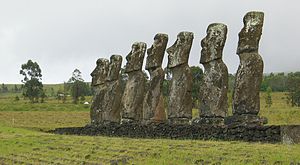Easter Island
Easter Island (in Spanish Isla de Pascua) is an island 3,510 km (2,180 mi) west of continental Chile, to which it belongs since its annexation in 1888. Forming a triangle 14 miles long by seven miles wide, it has an area of 63.1 sq mi (163.6 km2). Of volcanic origin, Easter Island is covered generally with grasslands and is swept by strong trade winds. Its climate is temperate with temperatures ranging between 18°C (64°F) in the winter (July) and 28°C (82°F) in the summer (January). Its highest point, Mount Terevaka, is 1,969 feet (600 metres) above sea level.
The island has an estimated population (2009) of 4,781. Its mixed population is predominantly of Polynesian descent ("Rapanui people"); almost all live in the village of Hanga Roa on the sheltered west coast. The island is a province that is administratively part of the region of Valparaíso, Chile. Prior to 1862, the inhabitants subsisted mainly on cultivated crops, with sweet potatoes being the most important. Easter Islanders continue to farm small plots today, although maize is now the major crop. Since the introduction of sheep ranching, sheep and cattle on the island have been the primary sources of meat. In addition to farming and fishing, Easter Islanders now work for the government, in a few small businesses, and in the tourist industry.
The island, the easternmost outpost of Polynesia, has long been famous for the petroglyphs (hieroglyphics in stone) and remarkable monolithic stone heads ("Moai"). The statues, carved from tuva, a soft volcanic stone, range in height from 10 to 40 ft (3 to 12 m), some weighing as much as 75 ton (75,000 kg). They were sculptured between the years 1250 and 1500.
The first European visitors, Dutch sailors under Jacob Roggeveen who were in search of Terra Australis, named it Paaseiland (Easter Island) because they discovered it on Easter Sunday April 5, 1722. To its original inhabitants the island is known as Rapa Nui (Great Rapa) or Te Pito te Henua (Navel of the World).


